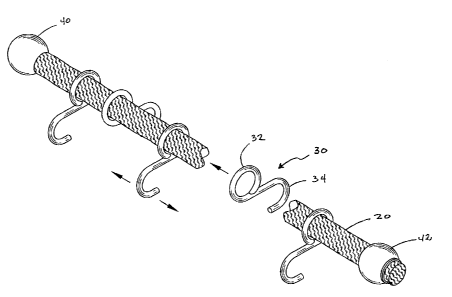Une partie des informations de ce site Web a été fournie par des sources externes. Le gouvernement du Canada n'assume aucune responsabilité concernant la précision, l'actualité ou la fiabilité des informations fournies par les sources externes. Les utilisateurs qui désirent employer cette information devraient consulter directement la source des informations. Le contenu fourni par les sources externes n'est pas assujetti aux exigences sur les langues officielles, la protection des renseignements personnels et l'accessibilité.
L'apparition de différences dans le texte et l'image des Revendications et de l'Abrégé dépend du moment auquel le document est publié. Les textes des Revendications et de l'Abrégé sont affichés :
| (12) Brevet: | (11) CA 2632065 |
|---|---|
| (54) Titre français: | CORDON A GLISSIERE |
| (54) Titre anglais: | ZIPPER CORD |
| Statut: | Octroyé |
| (51) Classification internationale des brevets (CIB): |
|
|---|---|
| (72) Inventeurs : |
|
| (73) Titulaires : |
|
| (71) Demandeurs : |
|
| (74) Agent: | BENNETT JONES LLP |
| (74) Co-agent: | |
| (45) Délivré: | 2012-10-02 |
| (22) Date de dépôt: | 2008-05-20 |
| (41) Mise à la disponibilité du public: | 2009-07-08 |
| Requête d'examen: | 2011-08-19 |
| Licence disponible: | S.O. |
| (25) Langue des documents déposés: | Anglais |
| Traité de coopération en matière de brevets (PCT): | Non |
|---|
| (30) Données de priorité de la demande: | ||||||
|---|---|---|---|---|---|---|
|
La présente invention propose un dispositif de fixation de chargement comprenant : a) un câble ayant une première extrémité et une seconde extrémité; b) de multiples crochets, où le crochet a une première extrémité et une seconde extrémité, la première extrémité du crochet formant une boucle autour du câble grâce à quoi le crochet peut coulisser le long de la corde, mais ne peut pas être retiré de la corde, la seconde extrémité du crochet formant une forme en C; et c) une première butée fixée à la première extrémité de la corde et une deuxième butée fixée à la seconde extrémité de la corde, les butées étant efficaces pour empêcher les crochets de glisser hors de la corde.
The present invention features a load-securing device comprising (a) a rope having a first end and second end; (b) multiple hooks, wherein the hook has a first end and a second end, the first end of the hook forms a loop around the rope where the hook can slide along the rope but cannot be removed from the rope, the second end of the hook forms a C-shape; and (c) a first stopper attached to the first end of the rope and a second stopper attached to the second end of the rope, the stoppers being effective to prevent the hooks from sliding off the rope.
Note : Les revendications sont présentées dans la langue officielle dans laquelle elles ont été soumises.
Note : Les descriptions sont présentées dans la langue officielle dans laquelle elles ont été soumises.

Pour une meilleure compréhension de l'état de la demande ou brevet qui figure sur cette page, la rubrique Mise en garde , et les descriptions de Brevet , États administratifs , Taxes périodiques et Historique des paiements devraient être consultées.
| Titre | Date |
|---|---|
| Date de délivrance prévu | 2012-10-02 |
| (22) Dépôt | 2008-05-20 |
| (41) Mise à la disponibilité du public | 2009-07-08 |
| Requête d'examen | 2011-08-19 |
| (45) Délivré | 2012-10-02 |
Il n'y a pas d'historique d'abandonnement
Dernier paiement au montant de 253,00 $ a été reçu le 2024-04-30
Montants des taxes pour le maintien en état à venir
| Description | Date | Montant |
|---|---|---|
| Prochain paiement si taxe générale | 2025-05-20 | 624,00 $ |
| Prochain paiement si taxe applicable aux petites entités | 2025-05-20 | 253,00 $ |
Avis : Si le paiement en totalité n'a pas été reçu au plus tard à la date indiquée, une taxe supplémentaire peut être imposée, soit une des taxes suivantes :
Les taxes sur les brevets sont ajustées au 1er janvier de chaque année. Les montants ci-dessus sont les montants actuels s'ils sont reçus au plus tard le 31 décembre de l'année en cours.
Veuillez vous référer à la page web des
taxes sur les brevets
de l'OPIC pour voir tous les montants actuels des taxes.
Les titulaires actuels et antérieures au dossier sont affichés en ordre alphabétique.
| Titulaires actuels au dossier |
|---|
| GOESON, BLAINE B. |
| Titulaires antérieures au dossier |
|---|
| S.O. |